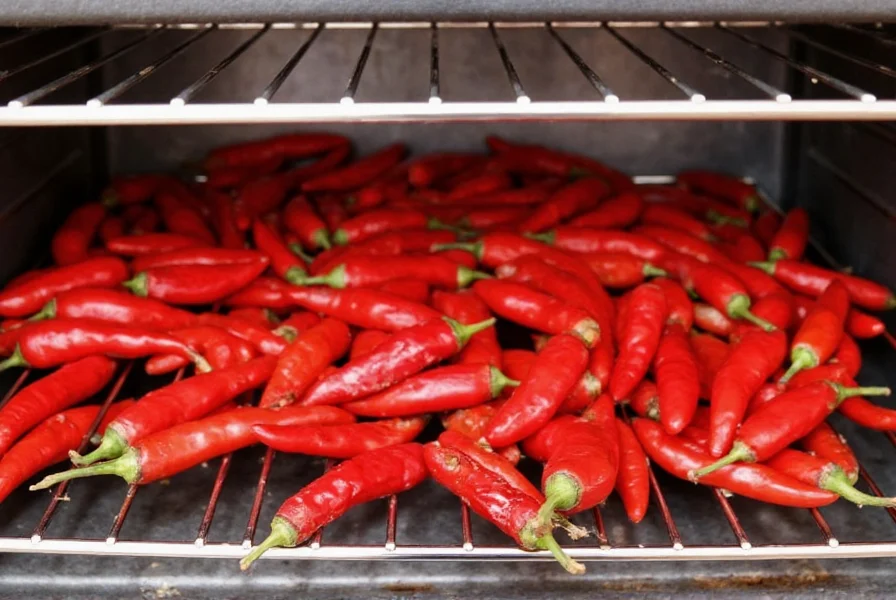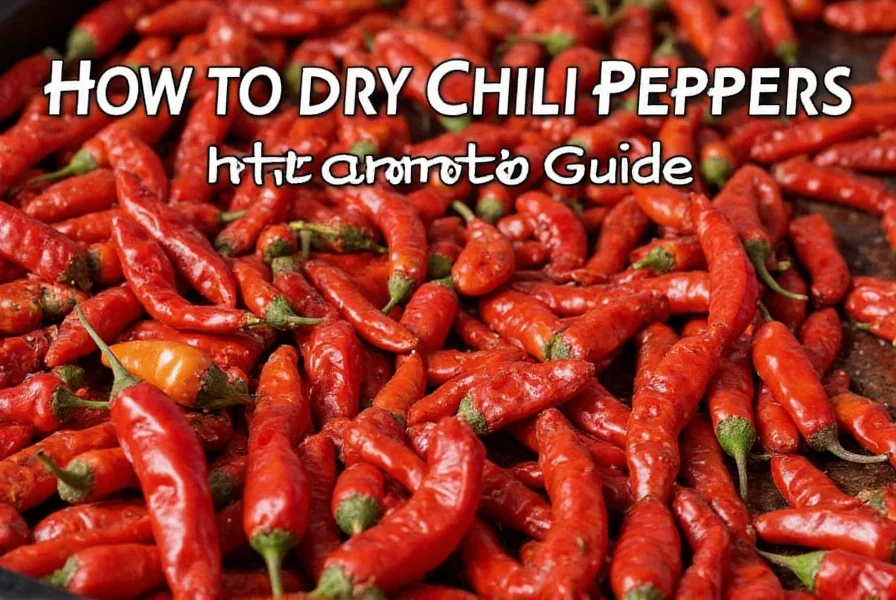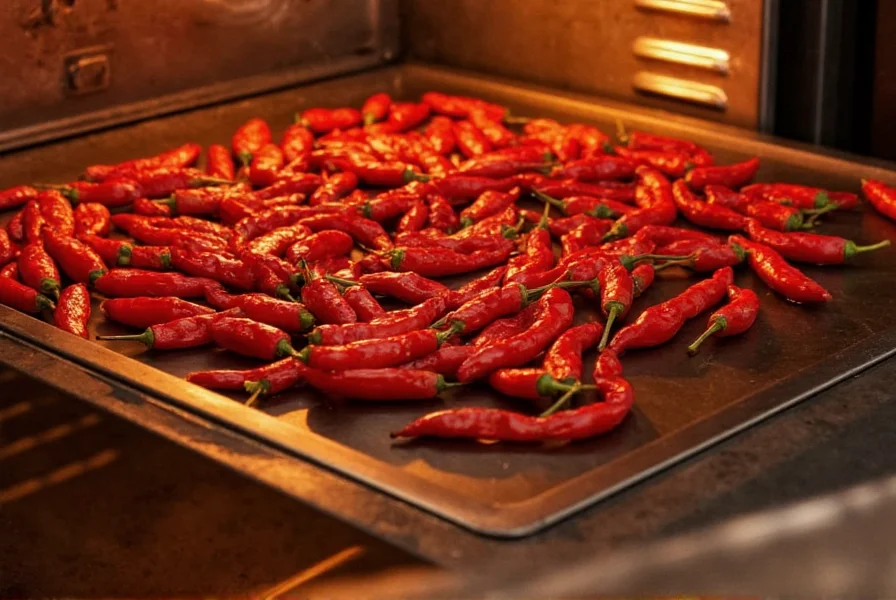Complete Guide to Drying Chili Peppers in Your Oven
Drying chili peppers at home preserves their fiery flavor and extends their shelf life significantly. This method transforms fresh peppers into versatile ingredients perfect for spice blends, cooking, and long-term storage. Oven drying offers a controlled environment that's more reliable than sun drying, especially in humid climates, and requires no special equipment beyond your standard kitchen oven.Why Oven Drying Beats Other Methods
While food dehydrators provide precise temperature control, most households already have an oven, making it the most accessible drying method. Compared to sun drying, oven drying completes the process in hours rather than days and eliminates concerns about insects, rain, or inconsistent temperatures affecting your harvest.
Essential Equipment for Successful Oven Drying
You'll need minimal equipment to dry chili peppers properly:
- Baking sheets or oven-safe trays
- Parchment paper or silicone mats
- Sharp knife and cutting board
- Oven thermometer (critical for accuracy)
- Cooling rack
- Airtight containers for storage

Step-by-Step Oven Drying Process
Preparation: Cleaning and Slicing
Start with fresh, firm chili peppers free from blemishes. Wash thoroughly and pat completely dry. For optimal drying:
- Slice peppers lengthwise to expose maximum surface area
- Remove seeds and membranes if you prefer milder heat
- Leave small peppers like bird's eye chilies whole with stems intact
- Arrange slices cut-side up on baking sheets
Optimal Oven Settings and Timing
Temperature control is crucial for proper drying without cooking:
| Pepper Type | Temperature | Drying Time | Doneness Test |
|---|---|---|---|
| Thin-walled (Jalapeños, Serranos) | 140°F (60°C) | 6-8 hours | Brittle, snaps when bent |
| Thick-walled (Bell peppers, Cubanelles) | 130°F (55°C) | 8-12 hours | No moisture when squeezed |
| Small hot peppers (Bird's eye, Thai) | 150°F (65°C) | 4-6 hours | Shrunk, leathery texture |
Place baking sheets in the oven with the door propped open 2-3 inches using a wooden spoon. This allows moisture to escape. Rotate trays every 2 hours for even drying. Never exceed 170°F (77°C) as higher temperatures destroy capsaicin and essential oils.
Troubleshooting Common Drying Issues
Even with careful preparation, you might encounter these common problems:
- Peppers are drying too slowly: Check oven temperature with a separate thermometer; household ovens often run hotter than displayed settings
- Peppers are cooking instead of drying: Temperature is too high; reduce by 10-15°F and increase door gap
- Mold developing: Insufficient airflow; increase oven door gap and ensure peppers aren't touching
- Inconsistent drying: Rotate trays more frequently and rearrange pepper positions
Proper Storage for Maximum Shelf Life
Correct storage determines how long your dried peppers maintain flavor and potency:
- Allow peppers to cool completely at room temperature (1-2 hours)
- Test for complete dryness by bending a piece—it should snap, not bend
- Store in airtight glass containers away from light and heat
- Include silica gel packets to absorb residual moisture
- Check weekly for first month for any moisture development
Properly dried and stored chili peppers maintain peak quality for 1-2 years. For extended storage up to 5 years, vacuum seal with oxygen absorbers and freeze.

Creative Uses for Your Oven-Dried Peppers
Dried chili peppers offer culinary versatility beyond fresh ones:
- Grind into custom chili powder with toasted cumin and garlic
- Rehydrate in hot water for sauces and stews
- Create infused oils by steeping dried peppers in olive oil
- Add whole dried peppers to soups and remove before serving
- Make traditional Mexican mole with dried ancho and guajillo peppers
Safety Considerations When Handling Hot Peppers
Working with dried chili peppers concentrates capsaicin, requiring extra precautions:
- Always wear disposable gloves when handling hot varieties
- Avoid touching your face, especially eyes, during the process
- Work in a well-ventilated area as dried pepper dust can become airborne
- Wash hands thoroughly with soap after handling, even with gloves
- Consider wearing safety glasses when grinding dried peppers
Frequently Asked Questions
Can I dry whole chili peppers in the oven without slicing them?
Yes, you can dry whole chili peppers, but it takes significantly longer—up to 50% more time. Small peppers like Thai bird's eye can be dried whole, but larger varieties like jalapeños or habaneros should be sliced lengthwise for efficient moisture removal. Whole peppers require careful monitoring to ensure internal moisture fully evaporates without mold development.
What's the best temperature to dry chili peppers in a conventional oven?
The optimal temperature range is 130-150°F (55-65°C). Most home ovens don't maintain temperatures this low accurately, so using the oven's lowest setting (usually 170-175°F) with the door propped open is necessary. An external oven thermometer is essential for monitoring actual temperature, as built-in thermostats often lack precision at these low settings.
How do I know when my oven-dried chili peppers are properly dried?
Properly dried chili peppers should be brittle and snap easily when bent, not leathery or flexible. They shouldn't feel cool to the touch, indicating residual moisture. When stored in an airtight container, they shouldn't develop condensation. For thicker peppers, break one in half to check for any remaining moisture in the center flesh.
Can I use my convection oven to dry chili peppers faster?
Yes, convection ovens work well for drying chili peppers as the circulating air accelerates moisture removal. Reduce the temperature by 15-25°F compared to conventional oven settings and check peppers more frequently. Convection drying typically reduces processing time by 25-30%, but requires careful monitoring to prevent over-drying.
Should I remove seeds before drying chili peppers in the oven?
Removing seeds is optional and depends on your desired heat level. Seeds and white membranes contain most of the capsaicin, so removing them creates milder dried peppers. If you prefer maximum heat, leave them intact. Note that dried seeds become very brittle and can create airborne particles when handling, so many prefer removing them before drying for safety.











 浙公网安备
33010002000092号
浙公网安备
33010002000092号 浙B2-20120091-4
浙B2-20120091-4